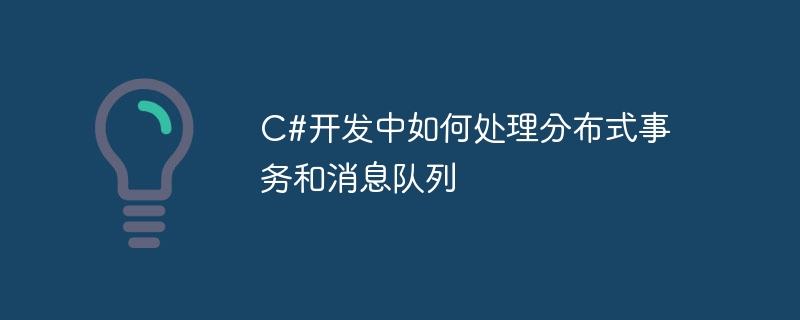

#How to deal with distributed transactions and message queues in C# development
Introduction:
In today's distributed systems, transactions and message queues are very important components. Distributed transactions and message queues play a crucial role in handling data consistency and system decoupling. This article will introduce how to handle distributed transactions and message queues in C# development, and give specific code examples.
1. Distributed transactions
Distributed transactions refer to transactions that span multiple databases or services. In distributed systems, how to ensure data consistency has become a major challenge. The following introduces two commonly used methods for processing distributed transactions:
public void TwoPhaseCommit()
{
using (var scope = new TransactionScope())
{
try
{
// 执行分布式事务操作1
DoSomethingWithDatabase1();
// 执行分布式事务操作2
DoSomethingWithDatabase2();
// 事务提交
scope.Complete();
}
catch (Exception ex)
{
// 事务回滚
scope.Dispose();
}
}
}public void SagaDemo()
{
try
{
// 执行分布式事务操作1
DoSomethingStep1();
// 执行分布式事务操作2
DoSomethingStep2();
// 执行分布式事务操作N
DoSomethingStepN();
// 事务提交
Commit();
}
catch (Exception ex)
{
// 发生异常,执行事务的回滚逻辑
Rollback();
}
} 2. Message Queue
Message queue is a way of transmitting messages in a distributed system. It has decoupling, Advantages such as asynchronous and peak-shaving and valley-filling. Here's how to use RabbitMQ as a message queue:
Create message producer
using RabbitMQ.Client;
public class MessageProducer
{
public void SendMessage()
{
var factory = new ConnectionFactory() { HostName = "localhost" };
using (var connection = factory.CreateConnection())
using (var channel = connection.CreateModel())
{
channel.QueueDeclare(queue: "message_queue",
durable: false,
exclusive: false,
autoDelete: false,
arguments: null);
string message = "Hello, World!";
var body = Encoding.UTF8.GetBytes(message);
channel.BasicPublish(exchange: "",
routingKey: "message_queue",
basicProperties: null,
body: body);
Console.WriteLine("Sent message: {0}", message);
}
}
}Create message consumer
using RabbitMQ.Client;
using RabbitMQ.Client.Events;
public class MessageConsumer
{
public void ConsumeMessage()
{
var factory = new ConnectionFactory() { HostName = "localhost" };
using (var connection = factory.CreateConnection())
using (var channel = connection.CreateModel())
{
channel.QueueDeclare(queue: "message_queue",
durable: false,
exclusive: false,
autoDelete: false,
arguments: null);
var consumer = new EventingBasicConsumer(channel);
consumer.Received += (model, ea) =>
{
var body = ea.Body.ToArray();
var message = Encoding.UTF8.GetString(body);
Console.WriteLine("Received message: {0}", message);
};
channel.BasicConsume(queue: "message_queue",
autoAck: true,
consumer: consumer);
Console.WriteLine("Waiting for messages...");
Console.ReadLine();
}
}
}Summary:
Introduction to this article Learn how to handle distributed transactions and message queues in C# development, and give specific code examples. Distributed transaction processing methods include Two-phase Commit and Saga mode, and the use of message queues can be implemented through RabbitMQ. In actual development, selecting appropriate processing methods and message queues based on specific business scenarios and needs can improve the stability and scalability of the system.
The above is the detailed content of How to deal with distributed transactions and message queues in C# development. For more information, please follow other related articles on the PHP Chinese website!
 ostringstream usage
ostringstream usage
 How to solve webstorm crash
How to solve webstorm crash
 Why is there no sound in Tencent meetings?
Why is there no sound in Tencent meetings?
 Why does the printer not print?
Why does the printer not print?
 phpstudy database cannot start solution
phpstudy database cannot start solution
 Introduction to commands for creating new files in Linux
Introduction to commands for creating new files in Linux
 What is blockchain web3.0
What is blockchain web3.0
 Where should I fill in my place of birth: province, city or county?
Where should I fill in my place of birth: province, city or county?




